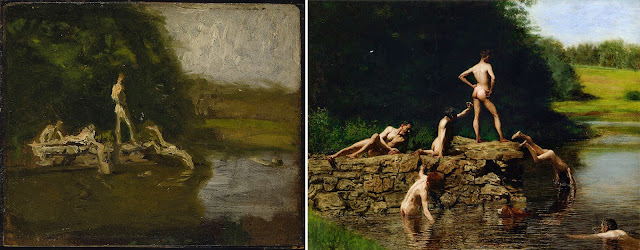When I was starting my way as an artist I've had a huge problem that annoyed my teacher - I was super slow at choosing and applying color. I was so accurate as if I had only one chance to do everything right. When my teacher was a young artist she did everything oppositely - she was making so much changes and layers on the canvas that eventually the paint cracks (it usually happens after the work is done, when the paint is trying to dry - here is my article about such troubles).
 |
| Here is 2 of my old color sketches. Usually I don't use my dog as a stand, but he wanted to participate in photoshoot |
Some professional artists (you know those adults who have never been kids) think that young artists don't do the sketches because of the laziness.
The truth is – young artists don’t do color sketches because they don’t know that they can. I was taught that color sketch is a prerogative of professional wise artists who usually do enormously huge paintings, so beginner artist's works seem not significant enough to have a color sketch.
 |
| I.Y.Repin - Sadko (1876) |
If only I knew that I can make a small color study before starting A3-A2 size painting – I will be calmer and more confident. It also helps to correlate dreams with reality, for example, if you do the grisaille, there can be an opposition of the value you’ve already paint and the value of the color you wanted to paint. The color sketch helps you to judge the value realistically before you've done the grisaille.
So here is the advice for the beginner artists - If you feel the uncertainty and fear about the colors – do a tiny sketch. I like to do them on 10x15 cm (4"x6") canvases. The trick is to forget about the shapes, lines, proportions and perspective – give yourself a time to concentrate only on colors. That allows you not to feel the crushing responsibility for the result and become more familiar with the main painting subject. And, finally, it’s a huge fun. But don’t forget to keep it really quick – usually 30 minutes is fine.
 |
| Thomas Eakins - The Swimming Hole (1884-1885) |
The idea is: if you are afraid of something – don’t hide from it. Instead concentrate on it and make it your friend. Tame your fears and you will win.
And don't forget that you can also sell this tiny painting.
Here is an interesting article on Wiki about the Oil Sketches - http://en.wikipedia.org/wiki/Oil_sketch
 |
| I.I. Levitan - By the Whirlpool (1892) |
By tradition, I need to crown this text with a pros and cons.
Oil color sketch Pros
- makes you feel more confident about the future painting- easy and fun
- can be sold as a painting
Cons
- takes your time- may interfere painterly and spontaneous approach

No comments:
Post a Comment